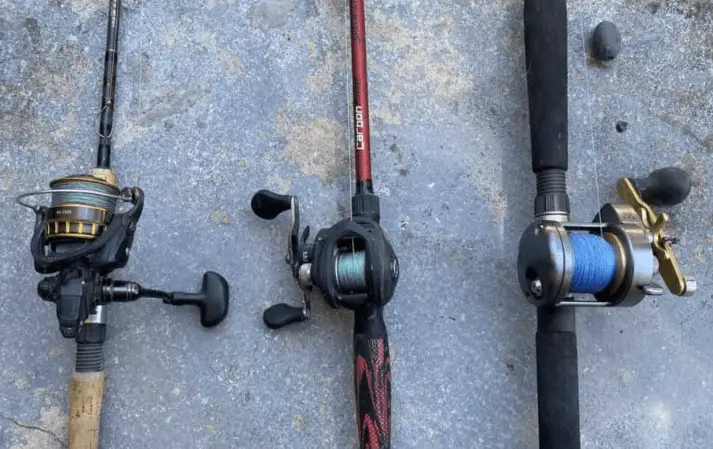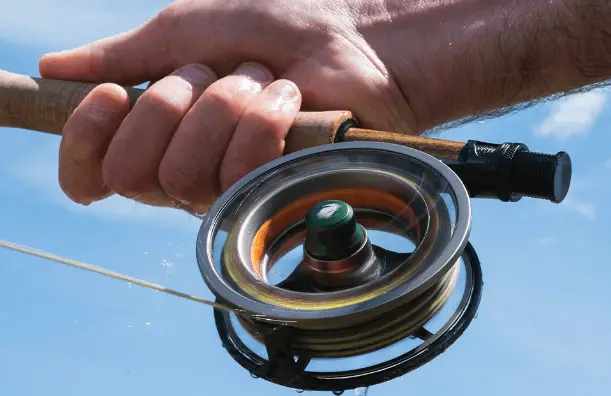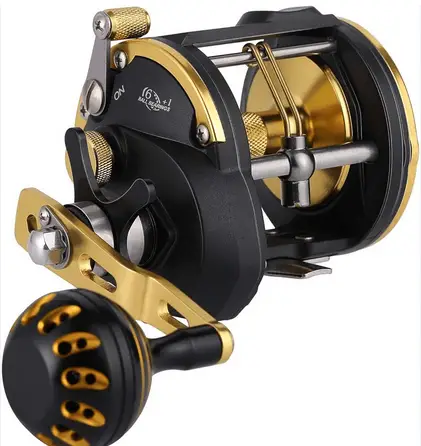In this article we will share complete details about of different types of fishing reels. after reading the article you wiil get an idea and you will find the best reels for fishing.
Types of Fishing Reels
There are three main types of fishing reels 1.spinning reels, 2.baitcasting reels 3.fly fishing reels. Every reel has a specific function based on the fishing method.
Fishing lovers are always in search of the perfect reel to match their preferred style and target species. Spinning reels are beginner-friendly and flexible, great for casting light lures and offering easy operability. Baitcasting reels, favored by experienced anglers, provide better control and accuracy for heavier lures and lines, and it is the best reels form others types of fishing reels .
Fly fishing reels, designed for the art of fly angling, are specialized for managing line smoothly during the cast and playing fish. Understanding the difference is essential to choosing the right reel, as it can significantly affect your fishing experience. With advancements in technology, these reels have become more ultramodern, catering to various fishing conditions and offering features such as improved drag systems, gear ratios, and construction materials, making the sport more accessible and enjoyable.
History Of Fishing Reels
The history of fishing reels is as fascinating as it is diverse. From simple wooden spools to intricate machinery, these devices have played a pivotal role in angling. Let’s dive into the depths of their origins and see how they have evolved over time.
Ancient Origins And Evolution
Fishing reels date back to ancient times. The first known illustration of a fishing reel comes from a 4th century AD Chinese work, showcasing a rudimentary reel used in conjunction with a rod. Early reels were basic, functioning mainly to store excess line. Variations of these early models could be found in other parts of the world, each reflecting the unique needs and materials available to the local fishermen.
- 4th century Chinese origins
- Simple line storage purpose
- Diverse global variations
Over the centuries, the design of fishing reels saw significant advancements. The introduction of gears and the concept of fly fishing in the 17th century marked the beginning of a new era in reel evolution. By the 19th century, reels had become more sophisticated, incorporating features like drag systems and varying gear ratios to accommodate different styles of fishing.
- Introduction of gears
- Emergence of fly fishing
- 19th-century innovations
Modern Developments In Reel Design
The modern fishing reel is a testament to human ingenuity. Today’s reels boast advanced materials like graphite and anodized aluminum, making them light yet durable. With a focus on ergonomics and precision, manufacturers employ cutting-edge technology to enhance the fishing experience.
| Advancement | Impact |
| High-tech materials | Strength and lightweight |
| Ergonomic designs | Comfort and control |
| Precision engineering | Efficient and effective casting |
- Graphite and anodized aluminum use
- Ergonomic handle designs
- Precision ball bearings for smooth operation
Innovations such as magnetic drag systems, infinitely variable gear ratios, and even computerized casting assistance are just a few examples of how modern fishing reels have transformed. These advancements provide unparalleled control and precision for anglers of every skill level.
- Magnetic drag systems for tension control
- Variable gear ratios for diverse fishing styles
- Computerized casting assistance
Spinning Reels
Anglers love spinning reels for their versatility and ease of use. These reels suit beginners and seasoned fishers alike. A spinning reel hangs beneath the rod, making it easy to monitor line movement. It is the best reels from many types of fishing reels.
Characteristics And Mechanism
Spinning reels have a fixed, open-faced spool. The spool sits parallel to the rod. A wire arm, or bail, flips to let the line out. When flipped back, it guides the line onto the spool as you reel in. This design minimizes line tangling.
The main components of a spinning reel include:
- Drag system: Adjusts how easily fish can pull line off.
- Handle: Turns the gears to wind the line back onto the spool.
- Bail: Keeps the line in place on the spool.
- Body: Holds all components together.
Working together, these parts make casting smooth. They allow for quick and precise retrievals as well.
Popular Uses And Species Targeted
Anglers use spinning reels in many fishing situations. They’re great for casting light baits and lures. Common setups include lightweight line and tackle.
A spinning reel often targets species such as:
| Freshwater Fish | Saltwater Fish |
| Bass | Snapper |
| Trout | Flounder |
| Panfish | Bonefish |
In freshwater or saltwater, spinning reels handle a broad range of fish. Anglers rely on them for their adaptability in various waters.
Baitcasting Reels
Baitcasting reels stand out in the fishing gear universe. Anglers praise them for their accuracy and strength. These reels sit atop the rod. This gives users a better angle for casting. Baitcasters work exceptionally well with heavier lines and lures. They suit the needs of those targeting bigger fish.
Design Features And Precision Control
The build of a baitcaster reel boasts unique traits.
- Its spool rotates as you cast. This offers a more natural motion.
- A tension knob allows fine-tuning of the release rate.
- Magnetic brakes help mitigate backlash, also known as “birds’ nests”.
- With a sturdy frame, baitcasters handle the stress of heavy fish.
The precision control gives anglers an edge. It helps to place lures exactly where they want them.
Techniques For Mastering Baitcasters
Conquering the baitcaster requires patience and practice.
- Start by adjusting the tension to match the lure weight.
- Practice with a heavy lure to feel the spool’s rhythm.
- Use your thumb to control the spool speed during a cast.
- Begin with short casts, gradually moving to longer distances.
Aim to become comfortable with these steps. Soon, the baitcaster feels like a natural extension of the arm.
Fly Fishing Reels
Delving into the world of angling brings us to the delicate art of fly fishing. Fly fishing reels are a cornerstone for this technique. They differ vastly from their conventional counterparts.
Unique Design For Fly Line Management
Fly reels showcase a unique build. Their purpose is to hold the fly line and backing effortlessly. This design ensures smooth casting and retrieval. Users find a large arbor design in most reels. This specific design prevents line memory and aids in swift line retrieval.
Key features include:
- Large Arbor for quick line retrieval
- Smooth Drag Systems that protect light tippets
- Simple Mechanisms for easy operation
Species And Fly Fishing Techniques
Different fish species call for diverse fly fishing methods.
| Fish Type | Reel Feature | Fly Fishing Technique |
| Trout | Standard Arbor | Wet Fly Swing |
| Salmon | Strong Drag | Spey Casting |
| Bass | Mid to Large Arbor | Streamers |
Matching the reel to both the target species and preferred technique is essential. It guarantees effectiveness and heightens the fishing experience.
Every angler must consider these factors before selecting a reel. Success on the water often hinges on these choices.
Trolling Reels
Let’s dive into the dynamic world of trolling reels, specialized equipment crafted for anglers seeking to land the big one. Trolling fishing involves dragging a lure or bait through the water from a moving boat, calling for a unique kind of reel. Understanding their features and uses can elevate your fishing game to new depths.
Built For Depth And Large Game Fish
Trolling reels are the powerhouses of fishing reels. They are designed to handle heavy lines and lure large game fish from the depths. These reels are robust and can deal with the strain of prolonged battles with sizeable adversaries.
- Deep-Water Capability: Reach the home of the giants below.
- Heavy Drag Systems: Maintain control over the toughest opponents.
- Large Line Capacity: Lets you fish deeper and fight longer.
Key Considerations For Trolling Enthusiasts
Choosing the right trolling reel is crucial for success. Below are essential aspects to consider:
| Feature | Importance |
| Material | Durability in saltwater conditions |
| Gearing | Smooth retrieval and performance |
| Drag System | Adjustment precision and range |
- Evaluate the type of fish you are targeting.
- Match reel line capacity to fishing depth and duration.
- Choose a reel with a comfortable handle for long hours.
Choosing Your Perfect Reel
Every angler knows the thrill of the catch starts with a good reel. With the right reel, you can cast, retrieve, and land fish with ease and precision. But not all reels are the same. People need different types to match their fishing style and the environments they explore. This part of the blog will guide you through the essentials of picking the reel that will work best for you. Let’s dive into what you need to consider.
Factors To Consider: Skill Level And Environment
Your skill level and the fishing environment are key in choosing a reel. Beginners might start with something simple. Experts may need more advanced reels. Consider these points:
- Simple Spincast: Good for newcomers, easy to use.
- Spinning Reel: Versatile, for all skill levels.
- Baitcasting: For the pros, offers precision.
- Fly Reels: Specialized, for fly fishing enthusiasts.
- Environment Matters: Saltwater calls for corrosion-resistant materials, while freshwater has different needs.
Think about the types of fish you’re after and the bodies of water you’ll visit. Match your reel to these factors and you’ll set yourself up for success.
Maintaining And Caring For Your Reel
Once you’ve found your perfect reel, you have to need it’s keep clean and maintenance . Proper maintenance can increase performance and extends reels life.
| Reel Care Task | Frequency |
| Clean after use | Every Trip |
| Oil moving parts | Monthly |
| Check for wear | Seasonally |
| Professional service | Yearly |
Follow these steps and read your reel’s manual. Small efforts keep your reel reliable. Enjoy seamless fishing trips with a well-cared-for reel.
FAQs for Types Of Fishing Reels
What Is The Best Reel For A Beginner?
The best reel for a beginner is a fixed spool or spinning reel. Simple to use, versatile, and affordable, it helps novices master casting techniques effectively.
What Reels Are Best For Fishing?
The best fishing reels depend on your target species and environment. Spinning reels are versatile for beginners, while baitcasting reels suit experienced anglers targeting larger fish. Fly reels are ideal for fly fishing. Choose based on durability, gear ratio, and comfort for your specific fishing needs.
Last Word
I hope you have found a detailed guide to choosing the perfect reel from the many types of fishing reels. Selecting the right fishing reel is crucial for a successful fishing. Spinning, baitcasting, spincast, fly, and surf reels each serve specific angling needs. Match your reel to your technique, and you’ll enhance your fishing experience. Tight lines and happy casting to all enthusiasts out there!



